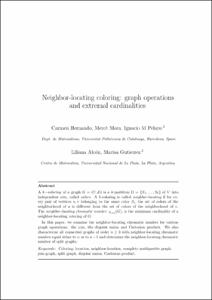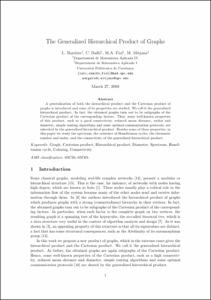Exploració per tema "Coloring"
Ara es mostren els items 1-9 de 9
-
Coloring decompositions of complete geometric graphs

(2019-06-25)
(2019-06-25)
Article
Accés obertA decomposition of a non-empty simple graph G is a pair [G,P] such that P is a set of non-empty induced subgraphs of G, and every edge of G belongs to exactly one subgraph in P. The chromatic index ¿'([G,P]) of a decomposition ... -
Neighbor-locating coloring: graph operations and extremal cardinalities

(2018-07-01)
(2018-07-01)
Article
Accés obertA k–coloring of a graph is a k-partition of V into independent sets, called colors. A k-coloring is called neighbor-locating if for every pair of vertices u, v belonging to the same color , the set of colors of the ... -
Neighbor-locating colorings in graphs

(2020-02-02)
(2020-02-02)
Article
Accés obertA k-coloring of a graph G is a k-partition of into independent sets, called colors. A k-coloring is called neighbor-locating if for every pair of vertices belonging to the same color , the set of colors of the neighborhood ... -
On the proper intervalization of colored caterpillar trees

(2009-11-01)
(2009-11-01)
Report de recerca
Accés obertThis paper studies the computational complexity of the Proper interval colored graph problem (picg), when the input graph is a colored caterpillar, parameterized by hair length. In order prove our result we establish a ... -
On the proper intervalization of colored caterpillar trees

(2009)
(2009)
Article
Accés restringit per política de l'editorialThis paper studies the computational complexity of the proper interval colored graph problem (picg), when the input graph is a colored caterpillar, parameterized by hair length. In order prove our result we establish a ... -
Quantum annealing of a hard combinatorial problem

(Universitat Politècnica de Catalunya, 2011-02-04)
(Universitat Politècnica de Catalunya, 2011-02-04)
Projecte Final de Màster Oficial
Accés obertWe present the numerical results obtained using quantum annealing (QA) in a hard combinatorial problem: the coloring problem (q-COL) of an Erd˝os-R´enyi graph. We first propose a quantum coloring Hamiltonian, natural ... -
The neighbor-locating-chromatic number of trees and unicyclic graphs

(2023)
(2023)
Article
Accés obertA k-coloring of a graph G is a partition of the vertices of G into k independent sets, which are called colors. A k-coloring is neighbor-locating if any two vertices belonging to the same color can be distinguished from ... -
The generalized hierarchical product of graphs

(2008-01)
(2008-01)
Article
Accés obertA generalization of both the hierarchical product and the Cartesian product of graphs is introduced and some of its properties are studied. We call it the generalized hierarchical product. In fact, the obtained graphs ... -
The neighbor-locating-chromatic number of pseudotrees

(2019-03-28)
(2019-03-28)
Report de recerca
Accés obertAk-coloringof a graphGis a partition of the vertices ofGintokindependent sets,which are calledcolors. Ak-coloring isneighbor-locatingif any two vertices belongingto the same color can be distinguished from each other by ...









